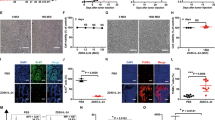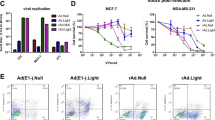Abstract
We previously reported that RGD fiber-mutant adenovirus vector carrying human TNFα cDNA (AdRGD-TNFα) could more effectively induce mouse B16 BL6 melanoma regression than conventional Ad-TNFα on intratumoral injection at less than 109 vector particles (VP). Although mice treated with either Ad type at 1010 VP showed remarkable tumor regression due to hemolytic necrosis, severe adverse effects including extreme reduction in body weight were also induced by Ad treatment. Here, we attempted to elucidate the cause of the adverse effects to optimize the application of AdRGD-TNFα. More than 99% of systemically administered Ad accumulated in the liver, and the rate of Ad leakage into systemic circulation from the B16 BL6 tumors injected with AdRGD or conventional Ad at 1010 VP was about 1% of the administered VP. Although the leaked Ad did not directly induce hepatotoxicity or body weight reduction, excessive TNFα produced in the tumors leaked into the blood at high concentrations and caused systemic inflammation, tissue denaturation, and body weight reduction in mice injected intratumorally with AdRGD-TNFα or Ad-TNFα at 1010 VP. Our results demonstrated that an exact AdRGD-TNFα dosage must be determined to prevent TNFα leakage from tumors into systemic circulation, thereby enabling safe application of AdRGD-TNFα to clinical melanoma gene therapy in the future.
This is a preview of subscription content, access via your institution
Access options
Subscribe to this journal
Receive 12 print issues and online access
$259.00 per year
only $21.58 per issue
Buy this article
- Purchase on Springer Link
- Instant access to full article PDF
Prices may be subject to local taxes which are calculated during checkout




Similar content being viewed by others
References
Kay MA, Woo SL . Gene therapy for metabolic disorders. Trends Genet 1994; 10: 253–257.
Kozarsky KF, Wilson JM . Gene therapy: adenovirus vectors. Curr Opin Genet Dev 1993; 3: 499–503.
Hemmi S et al. The presence of human coxsackie virus and adenovirus receptor is associated with efficient adenovirus-mediated transgene expression in human melanoma cell cultures. Hum Gene Ther 1998; 9: 2363–2373.
Okada Y et al. Fiber-mutant technique can augment gene transduction efficacy and anti-tumor effects against established murine melanoma by cytokine-gene therapy using adenovirus vectors. Cancer Lett 2002; 177: 57–63.
Okada Y et al. Tumor necrosis factor α-gene therapy for an established murine melanoma using RGD (Arg–Gly–Asp) fiber-mutant adenovirus vectors. Jpn J Cancer Res 2002; 93: 436–444.
Mizuguchi H et al. A simplified system for constructing recombinant adenoviral vectors containing heterologous peptides in the HI loop of their fiber knob. Gene Ther 2001; 8: 730–735.
Okada N et al. Efficient gene delivery into dendritic cells by fiber-mutant adenovirus vectors. Biochem Biophys Res Commun 2001; 282: 173–179.
Okada N et al. Efficient antigen gene transduction using Arg–Gly–Asp fiber-mutant adenovirus vectors can potentiate anti-tumor vaccine efficacy and maturation of murine dendritic cells. Cancer Res 2001; 61: 7913–7919.
Toloza EM et al. In vivo cancer gene therapy with a recombinant interleukin-2 adenovirus vector. Cancer Gene Ther 1996; 3: 11–17.
Chapman PB et al. Clinical pharmacology of recombinant human tumor necrosis factor in patients with advanced cancer. J Clin Oncol 1987; 5: 1942–1951.
Sherman ML et al. Recombinant human tumor necrosis factor administered as a five-day continuous infusion in cancer patients: phase I toxicity and effects on lipid metabolism. Clin Oncol 1988; 6: 344–350.
Taguchi T . Phase I study of recombinant human tumor necrosis factor (rHu-TNF:PT-050). Cancer Detect Prev 1988; 12: 561–572.
Yang Y, Ertl HC, Wilson JM . MHC class I-restricted cytotoxic T lymphocytes to viral antigens destroy hepatocytes in mice infected with E1-deleted recombinant adenoviruses. Immunity 1994; 1: 433–442.
Yang Y, Li Q, Ertl HC, Wilson JM . Cellular and humoral immune responses to viral antigens create barriers to lung-directed gene therapy with recombinant adenoviruses. J Virol 1995; 69: 2004–2015.
Yang Y, Wilson JM . Clearance of adenovirus-infected hepatocytes by MHC class I-restricted CD4+ CTLs in vivo. J Immunol 1995; 155: 2564–2570.
Bergelson JM et al. Isolation of a common receptor for Coxsackie B viruses and adenoviruses 2 and 5. Science 1997; 275: 1320–1323.
Wickham TJ, Mathias P, Cheresh DA, Nemerow GR . Integrins αvβ3 and αvβ5 promote adenovirus internalization but not virus attachment. Cell 1993; 73: 309–319.
Wickham TJ, Filardo EJ, Cheresh DA, Nemerow GR . Integrin αvβ5 selectively promotes adenovirus mediated cell membrane permeabilization. J Cell Biol 1994; 127: 257–264.
Mizuguchi H et al. CAR- or αv integrin-binding ablated adenovirus vectors, but not fiber-modified vectors containing RGD peptide, do not change the systemic gene transfer properties in mice. Gene Ther 2002; 9: 769–776.
Fechner H et al. Expression of coxsackie adenovirus receptor and αv-integrin does not correlate with adenovector targeting in vivo indicating anatomical vector barriers. Gene Ther 1999; 9: 1520–1535.
Alemany R, Suzuki K, Curiel DT . Blood clearance rates of adenovirus type 5 in mice. J Gen Virol 2000; 81: 2605–2609.
De Leeuw AM, Brouwer A, Knook DL . Sinusoidal endothelial cells of the liver: fine structure and function in relation to age. J Electron Microsc Tech 1990; 14: 218–236.
Marr RA et al. Tumour therapy in mice using adenovirus vectors expressing human TNFα. Int J Oncol 1998; 12: 509–515.
Kianmanesh A et al. Intratumoral administration of low doses of an adenovirus vector encoding tumor necrosis factor α together with naive dendritic cells elicits significant suppression of tumor growth without toxicity. Hum Gene Ther 2001; 12: 2035–2049.
Marr RA et al. Tumour immunotherapy using an adenovirus vector expressing a membrane-bound mutant of murine TNFα. Gene Ther 1997; 4: 1181–1188.
Acknowledgements
We thank the Applied Medical Research Laboratory (Osaka, Japan) for technical assistance with HE staining, Yasushige Masunaga and Sayaka Iiyama (Kyoto Pharmaceutical University) for technical assistance with the RT-PCR analysis, and Makiko Kanehira and Naoko Nishino (Mukogawa Women's University) for assisting with the animal studies. The present study was supported in part by the Sasakawa Scientific Research Grant from The Japan Science Society, and by grants from the Ministry of Health and Welfare in Japan.
Author information
Authors and Affiliations
Rights and permissions
About this article
Cite this article
Okada, Y., Okada, N., Mizuguchi, H. et al. An investigation of adverse effects caused by the injection of high-dose TNFα-expressing adenovirus vector into established murine melanoma. Gene Ther 10, 700–705 (2003). https://doi.org/10.1038/sj.gt.3301876
Received:
Accepted:
Published:
Issue Date:
DOI: https://doi.org/10.1038/sj.gt.3301876
Keywords
This article is cited by
-
Adenovirus serotype 35 vector-mediated transduction following direct administration into organs of nonhuman primates
Gene Therapy (2009)
-
Transduction Properties of Adenovirus Serotype 35 Vectors After Intravenous Administration Into Nonhuman Primates
Molecular Therapy (2008)
-
Transcriptional targeting of RGD fiber-mutant adenovirus vectors can improve the safety of suicide gene therapy for murine melanoma
Cancer Gene Therapy (2005)



